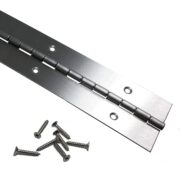Inspection frequencies for linear actuators depend on their operating hours and duty cycles. It also relies on environmental conditions and the level of application severity. This helps avoid serious failures that may lead to costly downtime. Balancing inspection costs against failure prevention creates optimal maintenance intervals. Require inspection scheduling based on operating hour accumulation, environmental exposure severity, load cycle intensity, visual condition monitoring, and preventive component replacement timing, establishing systematic maintenance programs that maximise reliability while minimising unnecessary service interventions.
Operating hour intervals
Equipment hour meters give a clear way to plan maintenance work. They replace old time-based or date-based schedules that do not match how machines are really used. Heavy industrial machines can reach thousands of hours every month. Hydraulic rams in nonstop mining or factory systems must be checked after 500 to 1000 working hours. Mobile construction units can run safely for 1000 to 2000 hours before service. This hour-based system links maintenance to real wear and not to fixed calendar dates. It helps avoid extra work on machines used less and prevents missed service on those used more. Manufacturer manuals give service times based on test results and real-use data. These rules change with cylinder size, pressure level, and type of work. Machines like industrial presses that run at high pressure need checks more often. Farm or field units working at medium pressure can follow longer service gaps. Mobile equipment subjected to shock loading and contamination exposure requires more aggressive maintenance schedules than stationary factory installations in clean, controlled environments.
Environmental condition factors
Operating environment conditions strongly decide how often inspection is needed. Harsh surroundings increase wear and damage faster. In marine use where saltwater is present, inspection should be done every month to find corrosion and check the seal condition.
- Marine environments require monthly corrosion inspections regardless of operating hours
- Mining operations inspect weekly for contamination and seal wear
- Arctic applications check monthly for cold-induced seal brittleness
- High-temperature industrial processes inspect seals quarterly for thermal degradation
- Agricultural equipment requires seasonal inspections addressing storage period deterioration
Outdoor equipment placed in open areas needs regular checking under all weather conditions. Harsh temperature shifts and long exposure to sunlight can wear out parts faster. Moisture and dust in the air also lead to slow damage.
Visual inspection schedules
Daily walk-around inspections by equipment operators provide first-line monitoring, detecting obvious problems like external leaks, damaged rods, or loose mountings.
- Daily operator checks for external leaks, damage, or unusual operation
- Weekly maintenance inspections examining rods, seals, and mounting bolts
- Monthly detailed assessments, including fluid sampling and pressure testing
- Quarterly teardown inspections on critical high-risk cylinders
- Annual comprehensive overhauls on severe-service applications
Hydraulic cylinder maintenance inspections should occur based on operating hour intervals matching usage, environmental condition factors, adjusting for exposure severity, load cycle intensity, considering frequency and magnitude, visual inspection schedules providing layered monitoring, and preventive replacement timing guided by component life data. These multiple scheduling criteria create comprehensive maintenance programs. The optimal inspection frequency balances failure prevention benefits against maintenance costs, establishing schedules that maximise equipment reliability and availability while controlling maintenance expenditures through efficient resource allocation.












Comments